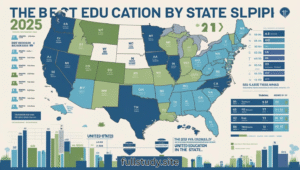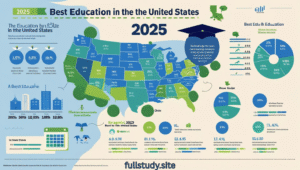
Among the foundations of both personal and society growth is education. Because of variations in funding, legislation, teacher credentials, and more, the quality of education can fluctuate greatly between one state in the United States to another. Based on many data factors including academic achievement, graduation rates, student-teacher ratios, and public funding per student, this thorough guide to the finest education by state in 2025 ranks each state.
Whether you’re a parent choosing where to relocate, a student preparing for college, or just wondering about how your state ranks, this thorough investigation will provide information on which states—and why—are driving change in education.
What Defines the Best State Education?
Understanding the main elements that constitute quality education in every state can help one to appreciate rankings later on. Usually considering the following criteria, experts evaluate the quality of education:
Academic performance for K–12
Rates of graduating from high school
SAT/ACT ratings of college readiness
Ratio of students to teachers
Public education funds per pupil.
Early childhood education: accessibility
Possibilities of higher education
Let’s examine which nations shine in each of these spheres closer-by.
Top 10 States with Greatest Educational Attractiveness 2025
Massachusetts 1.
Why does it come first?
Massachusetts’s great focus on academics and high public school funding helps it to regularly rank highest on the education lists. Over 90% of children graduate from high school, and the state claims top math and reading test scores among others.
Graduation percentage: 91.5%
For student spending, $20,315
One notable strength is access to top universities and best standardized exam results.
2. New Jersey
New Jersey has one of the lowest student-teacher ratios in the nation and gives early childhood education great priority. This helps to explain why it ranks #2. Its schools get great funding, which helps to explain their strong performance across levels.
90.2% is the graduation rate.
For student spending, $22,000
One notable strength is excellent teacher-to—student ratios and strong early education initiatives.
Connecticut 3.
Why does it come in at third?
Connecticut boasts a first-rate public education system and high student college preparedness. Its close proximity to many Ivy League universities also promotes a college-oriented atmosphere.
Grade of Graduation: 89.8%
For student spending, $21,000
notable strengths: strong SAT results, availability of top-notch higher education
Virginia 4.
Virginia strikes a mix between a great higher education system and top-notch public schools that results in a position of #4. Among the greatest high school Advanced Placement (AP) programs available nationwide are those offered below.
Graduation Percentage: 89.4%
Using student spending: $14,235
Highlights include military family support and STEM-oriented initiatives.
5. Vermont.
Vermont’s low student-to—teacher ratio and strong high school enrollment help to explain why it ranks #5. Rural yet, its educational system is well-funded and community-oriented.
Graduation Percentage: 90.6%
Based on student expenditure, $23,000
Notable strengths: great financing, individualized instruction.
Sixth: New Hampshire
Why it ranks #6: Small class sizes and strong civic involvement in education define this New England state. It routinely ranks highly on post-secondary and K–12 measures.
Graduation rate: 88.9%.

Based on student expenditure: $17,000
Notable strengths: low class numbers and active public participation.
Minnesota is number seven.
Minnesota excels in college preparedness and boasts very high rates of reading competence, which helps to explain why it ranks #7. The state funds teacher development and training extensively.
Graduation Percentage: 88.5%
For student spending, $15,700
Notable strengths: great rates of literacy, preparation for college
Rhode Island is number eight.
Why it comes in at number eight?
Though tiny in population, Rhode Island has achieved notable progress in educational reform—particularly in metropolitan school systems. It also has rather high rates of early childhood education involvement.
Graduation rate: 87.7%.
For student expenditure: $18,200
Notable strengths: early access to education, urban reform
9. Maryland
Maryland includes a balanced approach to academics and extracurricular activities and ranks #9 among all the states in the union for AP exam participation.
89.1% is the graduating rate.
Based on student expenditure: $16,550
High AP exam participation and a varied student body are notable strengths.
Ten: Washington
Washington gains from innovative education programs and high-tech industrial alliances, which is why it comes in at #10. For STEM teaching and student creativity, it does really nicely.
86.9% is the graduation rate.
Based on student expenditure: $14,800
Notable strengths: STEM projects, technologically advanced curricula
Rising States: honorable references
Over past years, many states have exhibited notable development. Though they might not yet rank among the top 10, they are worth observing:
Colorado: Emphasizing multilingual instruction and making increasing public school funding.
Texas: Raising career tech education and graduation rates
Georgia: High AP pass rates and projects for educational equity.
Florida: Robust virtual learning systems and growing programs for school choice
States Not Doing Well in Education
One should realize that different states have different resources and results. Among the states ranked lower on the education scale are such like:
Mississippi: Underfunded schools and poor exam results
New Mexico has high dropout rates and teacher shortages.
Alabama: Restricted availability of good pre-kindergarten programs
Louisiana: Battles graduation rates and student involvement.
West Virginia: Financial issues influencing education budgets
These states sometimes deal with a mix of policy problems, socioeconomic challenges, and inadequate educational funding. Many, though, have active reform initiatives in place with an eye toward long-term gains.
Developments Influencing Education for 2025
Knowing the best education available by state also calls for examining national trends. Following are some of the main elements influencing general educational quality in 2025:
1. Enhanced Technology Consumption
It is now standard practice to combine artificial intelligence tools with digital classrooms so that children in underprivileged and far-off places may get top-notch education.
2. Emphasize justice.
Closing achievement gaps across racial, economic, and geographic boundaries is more important to states these days.
3. Technical Education and Career Guidance (CTE)
Growing momentum surrounds CTE programs designed to equip students for real-world employment without necessarily requiring a four-year degree.
4. Help for Mental Health
To meet the growing need for mental health services, more colleges are funding counselors and emotional support workers.
5. Spread of Early Childhood Education
States making significant investments in Pre-K and kindergarten access are finding improved long-term academic results.
Which state offers the best education?
Although Massachusetts presently ranks highest among states for quality of education, many others are catching up with creative ideas and higher public funding. Local leadership, federal money, and social expectations shape the dynamic and always changing terrain of American education.
When assessing states for relocation, employment, or just kid education, take into account not just their rankings but also their particular strengths and challenges. The complicated ecology that is education depends on personal needs and priorities; the “best” typically follows from these factors.
FAQs Regarding State-Based Best Education
By 2025, which U.S. state boasts the best educational quality?
Based on exam results, funding, and graduation rates, Massachusetts today ranks #1 for education.
Which state pays most for every student?
Toping the list for per-student expenditure, Vermont and New Jersey each surpass $20,000 yearly.
By state, how does K-12 performance and college readiness vary?
While some states may shine in early education or technical training, others such as Connecticut and Minnesota show quite good levels of college preparedness.
Do richer states necessarily score better on education?
Funding is crucial, but so are community involvement, policy decisions, and leadership.
Leave a Reply